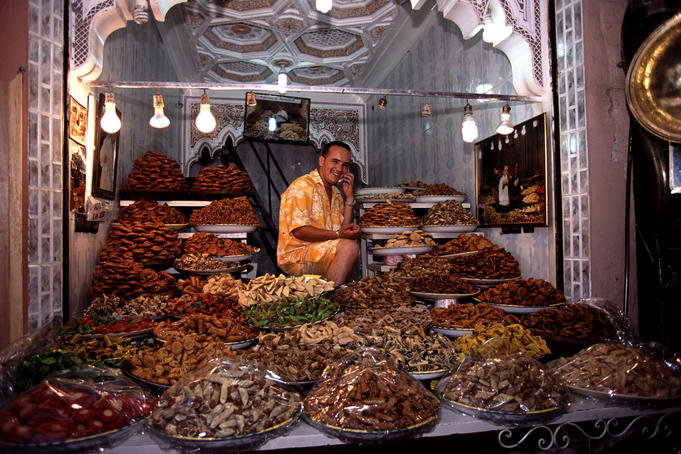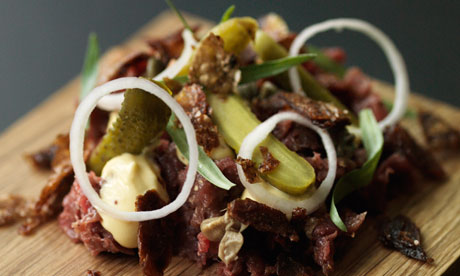Top 10 tips for devouring Moroccan cuisine
Words can’t do justice to the experience of cutting into a pigeon b’stilla (savoury-sweet pie made with fine pastry) and having its heady aromas of cinnamon, allspice and ginger engulf the table.
This famous dish, known for its unexpected melding of sweet and salty flavours and its perfectly balanced smooth and crisp textures, is an example of everything that is most wonderful about Moroccan cuisine – meltingly tender meat, aromatic ingredients, and presentation that is both theatrical and drop-dead gorgeous. Even atheists find foodie religion in Marrakesh, where the dishes keep coming until you protest 'Alhamdulillah', or 'Praise be to God'.

Imagine breakfasting on beghrir, pancakes with a spongy crumpet texture drizzled with cactus flower honey; lavishly lunching on mechoui, slow- roasted almond-stuffed lamb served with cumin, olives and khoobz (bread); and, after several laps of the souqs, mustering an appetite for a savoury, seasonal tagine (claypot stew). From Fès to Marrakesh and beyond, here are the top ten things that foodies should know to get the most out of culinary Morocco.
1. They've hand-picked Spain's favourite ingredients Like many Fassi dishes, b'stilla has its roots in Andalusia – it was from that part of Spain that ingredients such as olives, nuts, almonds, oranges and plums came and where the savoury-sweet technique was forged. These ingredients and many others have been absorbed into the national cuisine, enriching favourites such as couscous (fluffy semolina served with slow-simmered beef, chicken or vegetables; traditionally served on Fridays), harira (a thick, often lamb-based pulse soup flavoured with tomato, onion, parsley and coriander and finished with a squeeze of lemon), tajines (slow-cooked, highly flavoured stews of meats, veg and/or fruit cooked in conical earthenware pots over coals) and kefta (spiced minced lamb served as kebabs or in tajines).

2. You don't have to leave the vegetarians at home Vegetarian versions of Moroccan dishes are not uncommon; the traditional first course of a huge array of cooked salads is almost always vegetarian.
3. Cheap eats are on the streets Make sure you sample some of the street food too – snail soup, brochettes (kebabs) and kefta sandwiches are delicious and dangerous in equal parts (consider yourself warned), but roasted corn and freshly baked doughnuts, Moroccan pancakes and pastries stuffed with khlia (strips of mutton preserved in fat) are safe and oh-so-tasty. Also fabulous are b'sara (broad-bean purée with cumin, olive oil and a sprinkle of paprika) slathered on freshly baked khoobz (flat bread), and the delicate cornes de gazelle (horn-shaped pastry filled with almond paste, dipped in orange water and dusted with sugar).
4. Thirst quenchers To accompany your meals, there are plenty of tipples on offer. Freshly squeezed aseer limoon (orange juice) is available everywhere, as is sweet and scented thé b'na na (mint tea) and qahwa (coffee). Moroccan coffee is strong, short and served with spices. It can be ordered with sugar (wa sukkar) or without (bla sukkar); if you want a French-style cup, ask for café noir (black) or café au lait (with milk).
5. You'll want a glass of Sav Blanc with that Though Morocco is a Muslim country, there is an excellent range of local wine to choose from. A legacy of the French Mandate, the country's vineyards (60% of which are located around Meknès and Fès) produce extremely quaffable vintages. Stand-out products include Médaillon Sauvignon Blanc and Cabernet Sauvignon; Les Coteaux de L'Atlas 1er Cru Rouge and Blanc; S de Siroua Cabernet Sauvignon, rosé and Syrah; and Le Val d'Argan's El-Mogador red and white. Note that poor transport and cellaring of wine here can mean that the spoil rate is relatively high – if you encounter a spoiled bottle don't be afraid to send it back. The local lager is Flag Special, and you can also sometimes also order Casablanca.
6. Guilt-free desserts Few things make Marrakshis happier than to see guests eat with gusto, so go on, do your part for international relations and have dessert. Leave room for dessert bastilla (layers of flaky pastry with cream and toasted nuts).
7. Do-it-yourself If you're a fanatical foodie you might like to do a cookery course while you're in town. The affable Lahcen Beqqi runs half-day classes in Fès from the kitchen of Riad Tafi lalet in the medina – he'll take you shopping in the Ville Nouvelle's Central Market first and then cook a delicious lunch for you while you watch and (very occasionally) assist. The excellent chefs at Riad Souafine and Roumana both run classes that are more hands-on.
8. Marrakesh does it better In the Ville Nouvelle, you can join Marrakesh's rising middle class for pizza at Catanzaro and Niagara or barbecue at sidewalk restaurants along Rue ibn Aicha. Fashionable Marrakshis prefer restaurants that do double duty as discos.
9. Don't ask what's on the menu in a riad For superb home-style cooking, try a riad, where meals are made to order by the in-house dada (cook). Adventurous eaters tuck into steaming bowls of snails or sheep's-head stew at thronged stalls in the Djemaa el-Fna or Ben Youssef Food Stall Qissaria.
10. The places to avoid... For a big night out, Marrakesh has some fantastic Moroccan, Mediterranean and fusion restaurants – but also many tourist-trap 'palace restaurants'. If your footsteps echo, your waiter is sheepishly costumed like Aladdin and there's a stage set up for a laser-light show, don't expect authentic cuisine.
